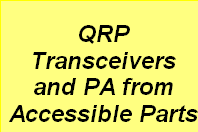

Antentop is FREE e-magazine devoted to Antennas and Amateur Radio an
Special page devoted to
Vertical
ZL- Beam Antenna for 430- MHz

Custom Search
|
ANTENTOP- 02- 2010, # 014 |
Vertical ZL- Beam Antenna for 430- MHz |
|
|
|
||
|
|
Vladimir Polyakov, RA3AAE,
Credit Line: HF- magazine, 1998, pp.: 27- 31 (published
in Russian in |
|
|
I would like to make a simple directional antenna. After I had observed lots variants I stopped at ZL- beam with two elements with active feeding. The antenna looked very attractive for me. This one at its small sizes (only lambda/8... lambda/10 in length) was practically the same parameters as 3- element YAGI.
|
Figure
1 shows a simple design of the ZL- beam. Points X-X
is the feeding terminal of the antenna. ZL- beam consists of two
dipoles (simple or folded) that connected together by crossed
wires. Depending on the length of the fires the dipoles fed by
some phase shift that helps form the diagram of directivity. (Note by I.G.:
More about ZL-Beam see References 1 and 2) |
|
|
Figure 1 ZL- Beam |
||
|
Required
phase shift between the antenna's elements
are obtained by two ways. At first, it needs change the length of
the crossed line. The second, (it is fine tuning) by changing of
the length of the dipoles. If the tuning may be made then no matter
at which points at the crossed line would be connected feeder of
the antenna. Usually ZL-beam is used as antenna with horizontal
polarization i.e. the dipoles are placed in parallel to ground.
That is because of the simplicity of that antenna design. |
I decided to make antenna with vertical placement of
the dipoles to ground. For the antenna's element should be suitable
J- Antenna. (Note by I.G.: More about J- Antenna see References
3 and 4). Figure 2 shows two version of that J- Antenna.
Version of the antenna with the grounded stub (right at the Figure 2)
is mostly suitable for my design. It is possible to connect the
lower point of the grounded stub with any ground- roof of the
car, metal mast and so on. It is possible to match the antenna
with any coaxial cable by choosing the feeding points. |
|
|
|
||
|
Page- 68 |
||
68 69
 |
 |
 |
 |
Just for Fun:

Powered byIP2Location.com
Thanks for your time!
Last Updated:
January 19, 2020 21:58






